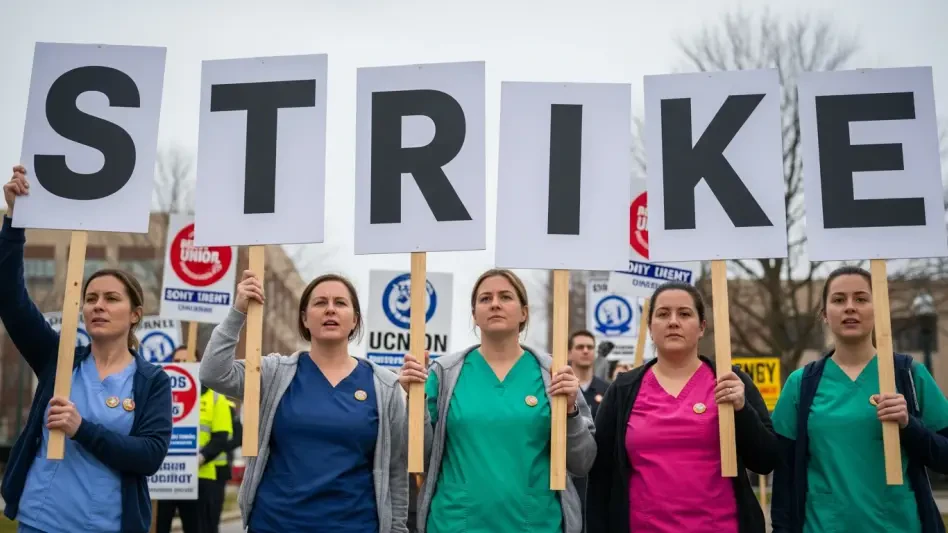In the heart of New Orleans, on a bitterly cold November morning, over 100 determined individuals bundled in coats and scarves stand shoulder to shoulder outside University Medical Center (UMC), their breath forming small clouds in the frigid air as they chant in unison. They are supporting a group of striking nurses who refuse to back down despite the chill, in a raw and urgent fight for change captured on November 11, as these healthcare workers demand better pay, benefits, and working conditions. Their resolve in the face of harsh weather underscores a deeper crisis in healthcare labor, one that has pushed them to strike for the fifth time in just over a year. What drives these nurses to take such a stand, and why does their struggle resonate so powerfully with the community?
The significance of this moment extends beyond the picket lines. It highlights a critical juncture in the ongoing battle between frontline healthcare workers and hospital administrations, not just in New Orleans but across the nation. The nurses’ protest is a vivid reminder of how deeply intertwined their working conditions are with patient safety and community well-being, making their cause a rallying cry for broader systemic reform.
A Chilling Stand for Change
The cold snap on this November day did little to deter the crowd gathered outside UMC. Protesters, ranging from fellow union members to local residents, waved signs and echoed chants that reverberated through the chilly air, amplifying the nurses’ plea for justice. Their presence was a testament to the gravity of the situation, as many braved the elements to stand in solidarity with healthcare workers who form the backbone of emergency and routine care in the city.
This event marks the fifth strike by UMC nurses in a short span, a frequency that signals persistent and unresolved grievances. Each action underscores a growing frustration with systemic issues that threaten not only the nurses’ livelihoods but also the quality of care provided to patients. The repeated disruptions point to a critical need for dialogue and resolution in a sector where the stakes are extraordinarily high.
The impact of these strikes ripples through the community, raising questions about how long such disputes can persist without compromising public health. As the nurses stand firm in the cold, their determination mirrors the urgency of addressing deep-seated challenges in healthcare labor, urging all stakeholders to prioritize lasting solutions.
Background of the UMC Nurses’ Struggle
The labor dispute at UMC has been simmering since negotiations for new staff contracts began in March of last year. Represented by National Nurses United (NNU), the nurses have been locked in a contentious battle with hospital administrators under LCMC Health, a nonprofit entity managing the facility. The talks have repeatedly stalled, fueling tensions and leading to multiple strikes as the nurses push for terms that reflect their critical role in patient care.
New Orleans, with its unique socioeconomic landscape, faces systemic healthcare challenges that amplify this conflict. Staffing shortages have long plagued local hospitals, compounded by difficulties in retaining experienced professionals who often leave for better opportunities elsewhere. These retention issues create a domino effect, straining remaining staff and diminishing care standards in a city where access to quality medical services is already uneven.
Against this backdrop, the UMC nurses’ struggle emerges as a focal point for broader concerns about healthcare delivery. Their fight is not just for personal gain but for a sustainable system that can serve the community effectively. The ongoing dispute with LCMC Health thus becomes a lens through which to view the larger crisis of workforce stability in regional healthcare.
Core Issues Driving the Strike
At the heart of the nurses’ demands are better wages, improved benefits, and safer working conditions. They argue that these enhancements are essential to retaining skilled staff, which directly correlates with patient safety and care quality. Without competitive compensation, the cycle of burnout and turnover continues unabated, leaving units understaffed and vulnerable.
Nurse Kisha Montes, who works in the behavioral health unit, has spoken candidly about the toll of overwork. She describes a vicious cycle where insufficient staffing drives exhaustion, prompting more nurses to leave, which in turn worsens the shortage. Her firsthand account, paired with an NNU report revealing LCMC Health’s $800 million profit over the past decade, paints a stark contrast between corporate gains and frontline struggles, fueling the nurses’ resolve to demand change.
The urgency of their cause is evident in personal stories and hard data alike. The nurses’ insistence on fair treatment is not merely a labor issue but a plea to prioritize patient outcomes over financial metrics. Their strike aims to force a reckoning with these disparities, pushing for a model of healthcare that values its workers as much as its bottom line.
Retention and Staffing Shortages
Retention remains the cornerstone of the nurses’ demands, echoed in their persistent chant of “retention, retention, retention” during protests. They emphasize that experienced staff are vital for mentoring newer nurses, ensuring that skills and institutional knowledge are passed down effectively. Losing seasoned professionals to burnout or better offers elsewhere disrupts this critical training cycle, compromising care standards.
The shortage of staff creates a high-pressure environment where mistakes become more likely, and patient safety is jeopardized. Nurses argue that without addressing retention through better pay and manageable workloads, hospitals risk a continuous drain of talent. Their focus is on building a stable workforce capable of handling the demands of a busy medical center like UMC.
This issue is particularly acute in a city with unique healthcare needs, where emergency cases often require swift, skilled responses. The nurses’ call for retention is thus a strategic push to safeguard both their profession and the community’s access to reliable medical support, highlighting a fundamental link between staff stability and public health.
Financial Critique of LCMC Health
The NNU report released during the strike casts a critical light on LCMC Health’s financial practices, revealing a high charge-to-cost ratio compared to other hospitals in New Orleans. This disparity suggests that patients are billed at rates far exceeding the cost of services, raising questions about affordability and access in a region marked by economic inequality.
Further scrutiny shows that executive compensation at LCMC Health surpasses the amount allocated to charity care by more than double, a statistic that has drawn sharp criticism from the union. Additionally, aggressive debt collection tactics, including wage garnishment and third-party harassment, have been flagged as contrary to the mission of a nonprofit healthcare provider, intensifying the nurses’ grievances.
These findings fuel the argument that LCMC Health prioritizes profit over community welfare and staff support. The nurses and their supporters contend that redirecting resources toward fair wages and better staffing could address many of the issues at hand, challenging the administration to align its practices with its stated nonprofit ethos.
Community and Labor Solidarity
The strike outside UMC drew remarkable support from over 100 community members who joined the nurses despite the cold. Their presence underscored a shared recognition of the indispensable role these healthcare workers play in managing everything from routine pregnancies to life-threatening emergencies, affirming that their fight is a communal one.
Labor organizations such as Step Up Louisiana and United Teachers of New Orleans also rallied behind the nurses, alongside unexpected allies like Starbucks Workers United. Local leaders, including Councilmember Oliver Thomas, voiced frustration over the need for nurses to protest for fair pay, amplifying the call for justice with statements that resonate with broader labor rights sentiments.
This coalition of support reflects a collective belief in the nurses’ cause as part of a larger movement for workers’ dignity. The solidarity on display illustrates how deeply the community values its healthcare providers, positioning the strike as a pivotal moment in advocating for systemic fairness across industries in New Orleans.
Hospital Administration’s Perspective
From the perspective of UMC’s administration, the union’s demands pose significant operational challenges. A spokesperson for the hospital highlighted that a proposed 60% wage increase, coupled with strict staffing restrictions, could limit flexibility in responding to emergencies or mass casualty events. This stance frames the nurses’ requests as potentially detrimental to critical care capabilities.
LCMC Health’s position emphasizes the financial and logistical constraints of running a major medical facility. The administration argues that balancing budget realities with the need to maintain service levels is a complex task, especially in a high-demand environment where unexpected crises are routine. Their concern is that conceding to all demands might strain resources beyond sustainable limits.
This viewpoint sharply contrasts with the nurses’ narrative, revealing a fundamental divide in priorities. While the nurses focus on worker welfare as a prerequisite for quality care, the hospital underscores institutional stability, setting the stage for a prolonged negotiation deadlock that continues to impact all parties involved.
Reflection and Broader Impacts
The strike at UMC serves as a microcosm of nationwide tensions in healthcare, where disputes over compensation, staffing, and patient care priorities are increasingly common. It encapsulates the struggle to reconcile the human cost of labor with the operational needs of medical institutions, a balance that remains elusive in many regions across the country.
Reflection
The strength of the nurses’ unified stand is evident in their persistence through multiple strikes and harsh weather, bolstered by robust community backing. Their ability to mobilize such support speaks to the legitimacy of their concerns and the public’s trust in their role. However, challenges persist, including the hospital’s operational worries and the apparent gridlock in negotiations that shows no immediate sign of resolution.
This impasse highlights the difficulty of achieving consensus in a sector where both sides have valid but conflicting priorities. The nurses’ determination is a powerful force, yet the administration’s constraints cannot be dismissed outright, creating a complex dynamic that demands innovative approaches to bridge the gap.
Broader Impact
The implications of this strike extend to future healthcare policy, potentially influencing how labor rights are addressed in medical settings. It raises critical questions about the ethical responsibilities of nonprofit hospitals to balance profit with public welfare, a debate that could shape legislative and regulatory frameworks in the coming years.
Moreover, the event contributes to the momentum of labor rights movements, inspiring other sectors to demand fair treatment. The visibility of the nurses’ fight, especially with community and inter-union support, may encourage a reevaluation of how healthcare systems prioritize their workforce, pushing for reforms that ensure sustainability and equity.
Looking Ahead: The Future of UMC Nurses’ Fight
The ongoing battle of UMC nurses with LCMC Health remains a poignant spotlight on systemic healthcare issues, from chronic understaffing to financial disparities. Their demands for better pay, benefits, and conditions are rooted in a desire to improve retention, which they tie directly to patient safety. Community solidarity, alongside critiques of the hospital’s financial practices, further amplifies their cause, painting a picture of a workforce fighting not just for itself but for the greater good.
Looking back, the strikes over the past year have demonstrated an unwavering commitment to change, even as negotiations faltered. The support from diverse groups and local leaders added weight to their struggle, while the clash with administration perspectives revealed the complexity of healthcare labor disputes.
Moving forward, stakeholders must explore mediation or policy interventions to break the current stalemate, ensuring that nurses’ voices shape the solutions. Community members and advocates are encouraged to stay informed about these negotiations, supporting initiatives that prioritize fair treatment for healthcare workers. The path ahead requires a collective effort to redefine how value is assigned to those who sustain public health, potentially setting a precedent for other hospitals nationwide.









